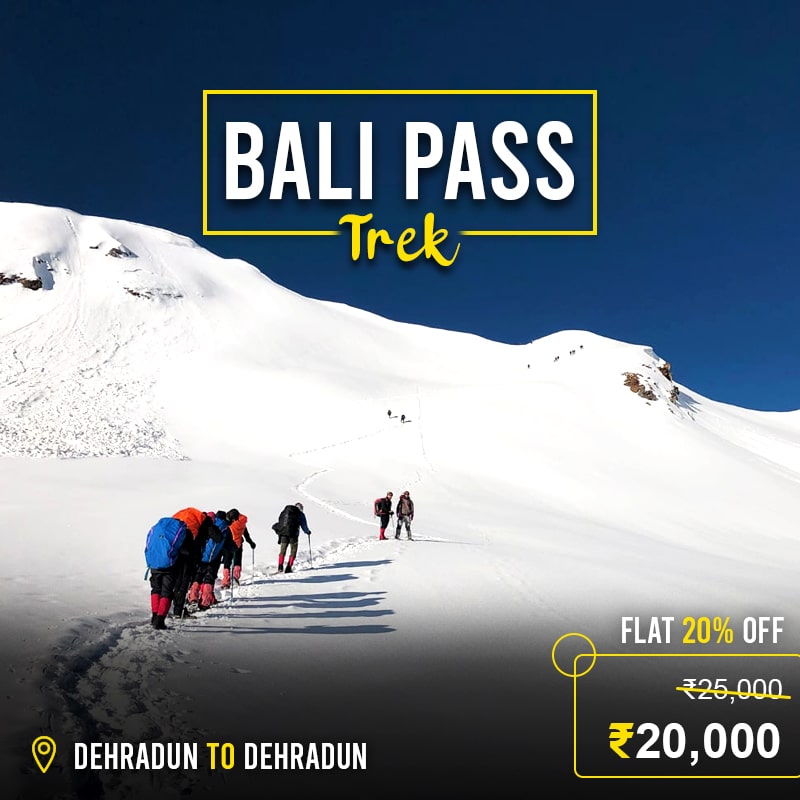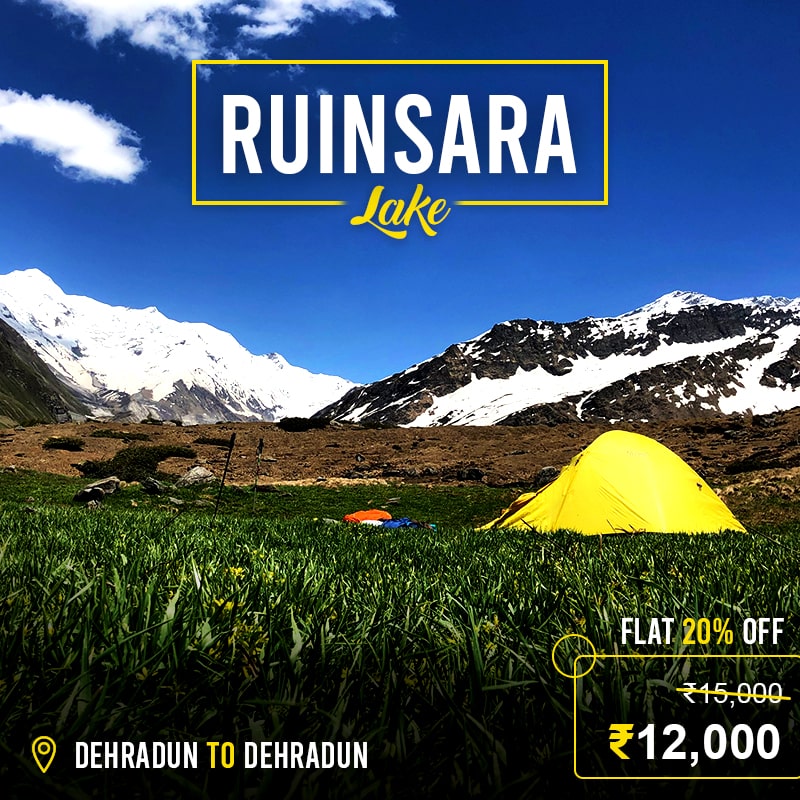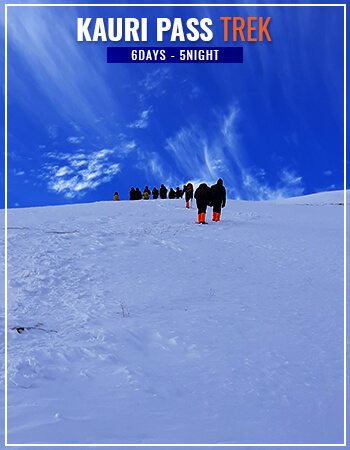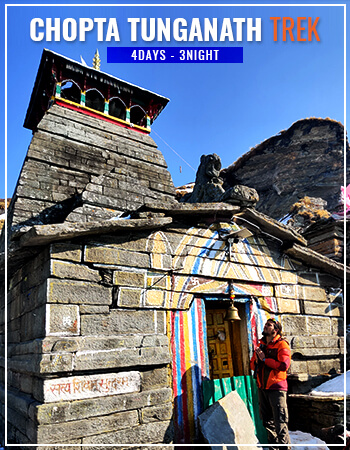ROOPKUND TREK
8 Days - 7 Night
8 Days - 7 Night
15,700 ft.
Moderate
Garhwal
ABOUT
ROOPKUND TREK
Roopkund Trek is without a doubt India’s most successful trek. Roopkund, also known as Mystery Lake, is a high-altitude glacial lake in Uttarakhand, India. Roopkund is located in the Trishul massif and is notable for the hundreds of human skeletons discovered at the lake’s shore. The Roopkund (lake) is about 15,700 feet above sea level. It is surrounded by ice-covered glaciers and snow-capped mountains, making it an ideal trekking location. The road to Roopkund passes across Ali and Bedni Bugyals, which are twin Bugyals. You can see peaks like Kedarnath, Chaukhamba, Neelkantha, Trishul, and Nanda Ghunti from the Roopkund trail.
SHORT ITINERARY
-
DAY 1
From Haldwani towards Lohajung
-
DAY 2
From Lohajung towards Tolpani
-
DAY 3
From Tolpani towards Patar Nachauni via Bedni Bugyal
-
DAY 4
Acclimatization and Rest Day
-
DAY 5
From Patar Nachauni towards Bhagwabasa
-
DAY 6
From Bhagwabasa towards Roopkund and return to Patar Nachauni
-
DAY 7
From Patar Nachauni towards Lohajung
-
DAY 8
From Lohajung towards Haldwani
DETAILed ITINERARY
Day 1: From Haldwani towards Lohajung
Arrive in Haldwani early in the morning and board your vehicles for the drive to Lohajung, the Roopkund trek’s starting point. The road winds its way through the scenic Kumaon valley. We travel through the towns of Almora and Kausani. You’ll get some stunning views of peaks like Kamet and Panchachuli along the way. By the evening, we’ll arrive in Lohajung and check into a guesthouse for the night. At 2300 meters, the town of Lohajung (the starting point of the Roopkund Trek) also serves as a small mountain pass that connects the Gwaldam and Wan sides of the mountain. Spend some time in the evening at Lohajung’s small market, which closes very early, or take in a lovely sunset from the balcony of your guest house. Take your dinner early and rest for the night.
Day 2: From Lohajung towards Tolpani
Our day’s trail is better than the rest of the journey, and we quickly get engrossed in its elegance. Following the Neel Ganga, we trek through the jungle. The trail is easy at first but gradually becomes more difficult. As the trek progresses, we settle in and begin negotiating the ascent to Ali Bugiyal. We arrive in Didina after a long hike. Tolpani is a gradual 1 km climb from Didina.
Day 3: From Tolpani towards Patar Nachauni via Bedni Bugyal
We’re getting up early today, not just to take advantage of the best views, but also because it’s going to be a long day. We’ll stroll through Ali and Bedni’s twin meadows. When we meet Ali Bugyal, the trail is steep. The trail then consists of long stretches of the rapid climb. On the hike, you’ll see that these meadows are among the best in the world. Nanga Ghunti and Trishuli are prominently visible in the east as you pass across the Ali Bugyal. We stick to the well-marked route. You’ll come across a small stone building. It’s a shrine, after all. A cluster of green fiber huts can be seen just to your right. Find a good place for the packed lunch here. A part of the trail ahead of you, beginning at the stone structure, is uphill and in a zigzag pattern. We start our trek after lunch and arrive at Bedni Bugyal Campsite in the afternoon. The journey is quick from here. Since the next campsite is not far away, walk quietly and gradually. When you abandon the Bedni Bugyal campsite, there is only one steep climb. Following that, there are parts of the gentle climb before we reach Patar Nachauni, which is located at the foothills of the peak, on top of which is the Kalua Vinayak temple. Remain in the camps.
Day 4: Acclimatization and Rest Day
After a long Day 4, the day is set aside for relaxation and acclimatization.
Day 5: From Patar Nachauni towards Bhagwabasa
While today’s trek is not particularly long in terms of distance, it contains one of the steepest sections of the entire journey. Getting a head start is often beneficial. To get to the summit, you must ascend the mountain directly in front of you. The trek begins with a flat walk before ascending steeply to the Kalua Vinayak Temple. Mountains obstruct the view in Patar Nachauni. However, once you arrive at Kalua Vinayak, you will be treated to a panoramic view. Kedarnath, Chaukhamba, Neelkantha, Trishul, and Nanda Ghunti are some of the prominent peaks seen from this vantage point. The trail descends from Kalua Vinayak to Bhgwabasa camps. Early in the afternoon, we arrive at Bhagwabasa camps. It is the Roopkund trek’s highest campsite. It’s bitterly cold here at night. The base camp for the trek to Roopkund Lake is Bhagwabasa.
Day 6: From Bhagwabasa towards Roopkund and return to Patar Nachauni
Today, getting a head start is crucial. If the evening progresses, the snow begins to melt, making the climb more challenging. The snow is new and quick to walk on in the morning. Today’s hike is a 4-kilometer gentle climb with steep stretches in between. To get to the Roopkund, you’ll have to descend 250 feet in the final stretch (lake). Roopkund is located at an elevation of 15750 feet. We’ll hike to Junargali, which is just 250 feet higher than Roopkund if the weather permits. We’ll return to Patar Nachauni after spending some time exploring. By late afternoon, you should be there.
Day 7: From Patar Nachauni towards Lohajung
Break camp early and travel to Wan. The trek today will take about 6-6.5 hours. We arrive in a village. We’ll stop for a while at Ghairoli Patal, which also serves as a nice camping spot. We must descend to the valley’s floor, where the river Neel Ganga awaits us. After a strenuous downhill trek, washing in the water is a good idea. It’s a half-hour climb uphill from the river to Wan. It’s another one and a half hour downhill from Wan village to Kasar Bagad, which is the route ahead. From here, we board a bus. Drive all the way up to Lohajung. In Lohajung, check into the Guest House. The Roopkund trek comes to an end here.
Day 8: From Lohajung towards Haldwani
Board the vehicle for the return trip to Haldwani in the morning. Arrive in Haldwani in the evening. It is recommended that you book your return flight from Kathgodam/Haldwani after 9 p.m. to ensure that you have enough time in case of road delays.
subscribe Now
DETAILed ITINERARY
Day 1: From Haldwani towards Lohajung
Arrive in Haldwani early in the morning and board your vehicles for the drive to Lohajung, the Roopkund trek's starting point. The road winds its way through the scenic Kumaon valley. We travel through the towns of Almora and Kausani. You'll get some stunning views of peaks like Kamet and Panchachuli along the way. By the evening, we'll arrive in Lohajung and check into a guesthouse for the night. At 2300 metres, the town of Lohajung (the starting point of the Roopkund Trek) also serves as a small mountain pass that connects the Gwaldam and Wan sides of the mountain. Spend some time in the evening at Lohajung's small market, which closes very early, or take in a lovely sunset from the balcony of your guest house. Take your dinner early and rest for the night.
Day 2: From Lohajung towards Tolpani
Our day's trail is better than the rest of the journey, and we quickly get engrossed in its elegance. Following the Neel Ganga, we trek through the jungle. The trail is easy at first, but gradually becomes more difficult. As the trek progresses, we settle in and begin negotiating the ascent to Ali Bugiyal. We arrive in Didina after a long hike. Tolpani is a gradual 1 km climb from Didina.
Day 3: From Tolpani towards Patar Nachauni via Bedni Bugyal
We're getting up early today, not just to take advantage of the best views, but also because it's going to be a long day. We'll stroll through Ali and Bedni's twin meadows. When we meet Ali Bugyal, the trail is steep. The trail then consists of long stretches of rapid climb. On the hike, you'll see that these meadows are among the best in the world. Nanga Ghunti and Trishuli are prominently visible in the east as you pass across the Ali Bugyal. We stick to the well-marked route. You'll come across a small stone building. It's a shrine, after all. A cluster of green fibre huts can be seen just to your right. Find a good place for the packed lunch here. A part of the trail ahead of you, beginning at the stone structure, is uphill and in a zigzag pattern. We start our trek after lunch and arrive at Bedni Bugyal Campsite in the afternoon. The journey is quick from here. Since the next campsite is not far away, walk quietly and gradually. Read More
Day 4: Acclimatization and Rest Day
After a long Day 4, the day is set aside for relaxation and acclimatisation.
Day 5: From Patar Nachauni towards Bhagwabasa
While today's trek is not particularly long in terms of distance, it contains one of the steepest sections of the entire journey. Getting a head start is often beneficial. Read More
Day 6: From Bhagwabasa towards Roopkund and return to Patar Nachauni
Today, getting a head start is crucial. If the evening progresses, the snow begins to melt, making the climb more challenging. The snow is new and quick to walk on in the morning. Today's hike is a 4-kilometer gentle climb with steep stretches in between. To get to the Roopkund, you'll have to descend 250 feet in the final stretch (lake). Roopkund is located at an elevation of 15750 feet. We'll hike to Junargali, which is just 250 feet higher than Roopkund, if the weather permits. We'll return to Patar Nachauni after spending some time exploring. By late afternoon, you should be there.
Day 7: From Patar Nachauni towards Lohajung
Break camp early and travel to Wan. The trek today will take about 6-6.5 hours. We arrive in a village. We'll stop for a while at Ghairoli Patal, which also serves as a nice camping spot. We must descend to the valley's floor, where the river Neel Ganga awaits us. After a strenuous downhill trek, washing in the water is a good idea. It's a half-hour climb uphill from the river to Wan. It's another one and a half hour downhill from Wan village to Kasar Bagad, which is the route ahead. From here, we board a bus. Drive all the way up to Lohajung. In Lohajung, check into the Guest House. The Roopkund trek comes to an end here.
Day 8: From Lohajung towards Haldwani
Board the vehicle for the return trip to Haldwani in the morning. Arrive in Haldwani in the evening. It is recommended that you book your return flight from Kathgodam/Haldwani after 9 p.m. to ensure that you have enough time in case of road delays.
subscribe Now
Get Quote
DEPATURE DATE
Everyday Batch. Call- +91-9458118063 | +91-7579480944
Everyday Batch. Call- +91-9458118063 | +91-7579480944
Everyday Batch. Call- +91-9458118063 | +91-7579480944
Everyday Batch. Call- +91-9458118063 | +91-7579480944
COST INCLUSION
-
Pick and Drop Service from mentioned location
-
Fees for the guide and the chef
-
Camping facilities' rent
-
Entrance fees to the forest
-
To transport camping gear, a porter and mule are required. Please keep in mind that personal baggage can be borne by mules and/or porters for a fee
-
From the first day's dinner until the last day's brunch, both of the meals are vegetarian
-
Throughout the walk, you'll be staying in a tent or if possible, then in a guest house
COST EXCLUSION
-
No pickup and drop point from/for your hometown
-
Personal costs include things like tips, personal medications, and conference calls, etc
-
Apart from what is mentioned above, some transportation assistance during the trek
-
Porters/mules can carry personal luggage weighing up to 12 kg per bag per person for Rs 350 per day per bag
Frequently asked question
- Footwear: The trekking boots which must be waterproof and snow proof, normal boots, floaters, and woolen socks.
- Backpack: (50 ltr), Daypack (20-30 ltr), Duffel bag.
- Clothes: Jacket and trousers that are both waterproof and breathable. Jacket (synthetic or down feather fleece), synthetic insulated trousers, poncho, sweatshirt, inner thermal (upper & lower), fleece, t-shirts, cotton trekking pants, shorts
- Season wise Clothes:
- Hand and head protection includes liner gloves, bandannas, sun hats, woollen caps, and face masks, among other things.
- Accessories: Sunglasses/goggles, anti-glare lenses, water bottle, hydra bag, and headlamp with spare bulb and extra batteries are all recommended.
- Trekking Gears: Toolkit for an emergency. Sunscreen, a toiletry pack, water purification pills, Ziploc packs, ear plugs, first-aid kit, and the necessary medications are all recommended.
- Camping Equipment: Sleeping bags of lining (extreme -5 to +5 Celsius if you have one), trekking sticks, and so on.
- Warm top/light micro fleece pullover/full sleeve T shirt – 2/3
- Water resistant/repellent trekking pants with an inner lining for added warmth- 2 High-quality windproof/water-resistant outer shell (jacket) with a proper hood
- Thick Fleece / Full-sleeve Woollen Jumper, Down Jacket with at least 600 fill capacity Innerwear with a thermal component (upper and lower)
- Woolen hat, inner fleece gloves, and outer water-resistant gloves
- 4–5 pairs of thick woollen socks and standard socks, scarf/muffler (optional)
- Waterproof Trekking/Hiking shoes with a thick heel and high ankles that are comfortable to wear. Sneakers/sport shoes are ideal for camp.
- Poncho or raincoat. A small, light-weight towel
- A hydration pack and an insulated water bottle (optional)
- Sunglasses with UV cover and the potential to cut light, as well as a cap or floppy hat to shield the strong sun off your skin (important when traversing through snow)
- Trekking pole or sturdy walking stick Lip Balm, Sunscreen Lotion
- Flashlight / torch (with extra batteries) Medications, if any special prescription is needed Toiletries for personal use
- Carry a rain cover over your luggage • Day pack/small bag that you can carry on your back all day to keep your essentials in
- Keep a few poly bags or plastic containers in your bag to place your things in if you need to in case of heavy weather.
Personal Medical Kit (MANDATORY FOR ALL)
- 10 Diamox tablets (to prevent AMS)
- Nifedipine – 5 pills Dexamethasone – one strip
- 6 tablets of Crocin (fever)
- 4 tablets of avomine (motion sickness) 4 capsules of Avil 25mg (allergies)
- 4 tablets of Combiflam (Pain killer)
- 6 tablets each of Norflox TZ and Lomofen (diarrhea) 10 tablets of Digene (acidity)
- 10 Omez/Rantadine capsules (antacids) 3 to 5 metres of crepe bandage
- 1 tiny roll of gauze 10 strips of bandage 1 small roll of cotton 10 packets of ORS
- Moov spray Betadine or other antiseptic cream (aches, & sprains)
- If you're vulnerable to knee injuries, you should wear a knee cap. Powder with antifungal properties
- Cancellation: If a trek is cancelled at the last minute due to a natural disaster or unforeseeable circumstances (such as floods, earthquakes, landslides, attack, or bandh), Discoveryhike will have a trek voucher for the full number. The voucher can be used for the same or a different trek over the next year.
- In case you wish to cancel the trek, then please be aware of these things:
- Cancellations made within 30 days of the trek's launch date will include a complete refund.
- If you cancel within 30 and 20 days before the hike, you will get a 50% refund.
- There will be no refund if you cancel less than 20 days before the trek begins.
- Please keep in mind that if you get a refund, there will be a reduction of 4% (Cancellation charges) from the overall amount you pay. In addition, if you purchased trek insurance, you would not get a refund.
- Discoveryhike assumes no responsibility for any malfunction or injury to your clothes, supplies, or other belongings while on the trek. The trek fee covers all expenses associated with the trek from start to finish.






